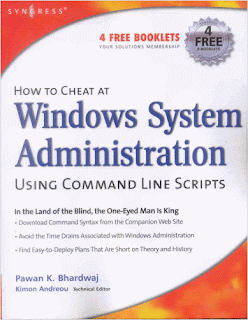
How To Cheat At Windows System Administration Using Command Line Scripts
Syngress, Paperback, Published September 2006, 400 pages, ISBN 1597491055
Essential Knowledge for Multitasked Managers
If you are like most managers in small to medium-sized enterprises, administering Windows is only one among many responsibilities. With every new version of Windows, Microsoft tries to ease administrators’ jobs by adding more layers of GUI or configuration wizards. Although these “wizards” are interactive and make the administrator’s job easier, they are not always the most convenient and most efficient way to accomplish everyday administration tasks. How to Cheat at Windows Administration Using Command Line Scripts uses a Best Practices approach to provide busy managers with clear, succinct instruction to accomplish a given task using the command-line utilities included with the operating system.
· Learn the Basics of the Command Shell
Learn how to access the command shell and customize its properties.
· Work with the Command Line Using a Nonadministrative Account
Change command input and output from the standard keyboard and the command shell window, and see how to handle errors.
· Master the Task Scheduler Service
Schedule tasks to run at predetermined times, and use different subcommands of the schtasks utility to create, change, delete, query, run, or end a task.
· Manage Files, Folders, and Floppy Disks
Learn the commands related to file and folder management, including Tree, MD (Mkdir), and RD (Rmdir).
· Cover Maintenance of File Systems and Hard Disks
Understand how to best use utilities such as Fsutil, Chkdsk, and Defrag as well as Format, Convert, and Compact.
· Use Diskpart to Manage Hard Disk Partitions
Use Diskpart to perform disk-related tasks, such as creating and deleting partitions and volumes, and creating, maintaining, and managing fault-tolerant volumes.
· Query, Add, Delete, and Save Registry Entries
See how to maintain the Windows operating system, including services, drivers, and the Windows Registry.
· Monitor and Manage Event Logs, Processes, and Logs
Learn how to view system services and applications using the TaskList command and how to terminate nonresponsive processes using TaskKill.
· Manage Printers and Print Jobs
Use the command line to view and configure installed printers and also to manage printer drivers and print queues.
· Manage Active Directory
Learn how to search for Active Directory objects, add and remove objects from the directory database, and modify an object’s properties.
· Perform Network Troubleshooting
Examine a number of network diagnostic tools, such as Ping, IPConfig, Pathping, Finger, and ARP, and learn to interpret their results.
About the Authors
Pawan K. Bhardwaj (MCSE, MCT, Security+, Network+, I-Net+ and A+) is an independent technical trainer and author. He has been actively involved in Windows administration ever since Windows NT 3.51 was released. In the past 16 years he has worked at various system and network support levels for small and medium-sized companies. Some of his major projects included working for one of India’s largest newspaper groups and a large e-commerce organization in the United States where he had an active involvement in design and implementation of large-scale LAN and WAN solutions based on Windows technologies.
Pawan was one of the first 100 in India to attain MCSE certification back in 1997. He teaches Windows administration and networking classes and also acts as a consultant to training institutions. He has authored or contributed to more than 12 certification books by Syngress/McGraw Hill. He also coauthored MCSE 2003 Electives Exams in a Nutshell (O’Reilly Media, Inc., 2006).
Kimon Andreou (Technical Editor) is IT Portfolio Manager at Royal Caribbean International in Miami, FL. His expertise is in software development, software quality assurance, data warehousing, and data security. Kimon’s experience includes positions as CTO for Secure Discovery Solutions, an e-Discovery company; Manager of Support & QA at S-doc, a software security company; and as Chief Solution Architect for SPSS in the Enabling Technology Division. He also has led projects in Asia, Europe, North America, and South America. Kimon holds a Bachelor of Science in Business Administration from the American College of Greece and a Master of Science in Management Information Systems from Florida International University.
BigDownload link :
BigDownload



No comments:
Post a Comment